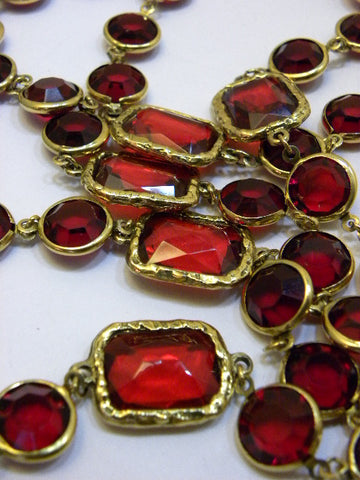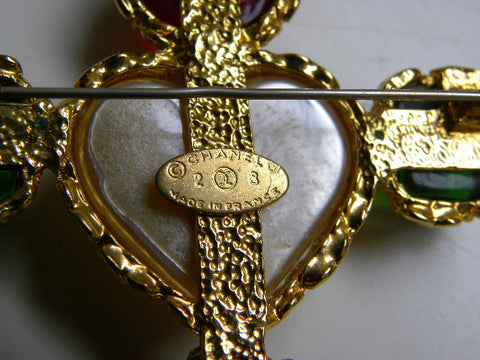Glossary
Aurora Borealis Finish(AB)
This is a rhinestone or cabochon that has been given an irridescent finish due to a metallic deposit in the stone. It is highly reflective, covering the colours of the rainbow, and is named after the Northern Hemisphere light display. It was invented by Swarovski in 1995.

Bail
This is a finding that is used to attach a pendant to a necklace
Baroque Pearl
An irregularly shaped pearl, somethings also referred to as a potato pearl. Chanel's pearls are usually made of glass.
Bezel Setting
A setting for a crystal or cabochon stone in which a thin metal strip is folded over and around the edge of the stone to hold it in place. On Chanel jewellery the bezel setting can be 'crimped' to great effect as is shown in the illustration.
Bracelet
Types of bracelets produced by Chanel include:
- Bangle - a rigid bracelet, no clasp, which slips on over the hand
- Charm - a chain bracelet with one or more ornaments, or charms, hanging off it. A very popular Chanel bracelet
- Cuff - a rigid oval or circular bracelet either joined with a clasp, or with a small opening through which the wrist is inserted
Cabochon
This describes an unfaceted stone or poured glass with a smooth surface and a flat base and was a very popular and much used stone. The use of cabochon stones of several different colours in an individual piece is a hallmark of Chanel design.
Clasp
The means by which a piece of jewellery is held in place. Types of clasp most commonly used by Chanel include:
- Spring Clasp - a ring with a small prong that allows the ring to be opened and attached to the opposite end of the bracelet or necklace. A spring ensures that the ring closes when the prong is released
- Lobster claw - a clasp which resembles a lobster's claw and which can be opened to attach to the other end of the chain
- Push-slot clasp - frequently used by Chanel on heavier necklaces, it comprises a narrow v-shaped plate that slots into a 'box and clicks into place. The box is often decorated with the Chanel double C logo
- Trombone clasp - usually used on a brooch or pin, it is a metal 'stopper' which is pulled out along the back of the pin to release the prong and is pushed back in over the end of the prong to hold it in place
- Turn clasp - typically used on brooches, the prong is inserted into the clasp and a turning closure ensures that the prong cannot come loose
Claw Setting
A setting for a stone which is held in place by a number of metal wrongs, or claws, usually so that the back of the stone can be open to allow more light to pass through it.
Emerald Cut
Used to describe a cut of stone or crystal that is rectangular in shape with step faceting and truncated corners.
Faceted
Refers to a stone or crystal the surface of which has been cut in a regular pattern into a number of 'faces' or facets, designed to enhance its reflectiveness and sparkle. This is the opposite of cabochon.
Faux
Literally means 'false' and is most commonly used when referring to the glass-based imitation pearls beloved by Coco Chanel. A faux pearl necklace was the first piece of costume jewellery she produced.
Foil Backed
Usually refers to rhinestones whose open back has been coated with a substance that enhances the colour and depth of the stone.
Givre Stones
These are stones made from transparent glass fused around a translucent core to give the stone a frosted appearance. The amazing effect can be seen in these beautiful white givre crystals.
Graduated
Usually used in reference to peal necklaces in which the larger pearls are at the front, with the pearls gradually diminishing in size towards the back of the necklace.
Hammered
A technique for decorating the surface of metal using a hammer or tool giving a similar effect.
Lariat
A long necklace with open ends (no clasp) that is kept in place by knotting or looping the ends.
Maltese Cross
A cross which has four arms of equal length, but where the width of each arm increases the further it gets from the centre.
Open-Backed
A setting for a stone in which it is set in a metal frame with an open back, allowing more light to pass through the stone. Often used with a claw setting.
Poured Glass
This is a technique by which glass is heated and then poured into moulds to shape it. The resultant glass is translucent and often contains small bubbles. It is then set into a metal setting, often a beautiful pendant or brooch.
Repousse
A method of decorating sheet metal in which designs are hammered on to the back of the metal using special tools. The resulting design is thus 'pushed through' to the front of the metal casing creating a raised pattern. This is an ancient technique for decorating metal surfaces.
Rhinestones
These are cut glass stones, usually small and circular, and often backed with foil to increase their reflectiveness and hence sparkle. When a rhinestone darkens it is usually due to damage to the foil backing.
Rondelle
This usually comprises two circular discs, often decorated with rhinestones on their outer edges, which Chanel uses as decorative spacers in its more elaborate necklaces.
Sautoir
A long necklace of pearls, crystals, pearls, and/or chains. Originally, the term referred to an open-ended necklace, but the term is now commonly used to refer to a longer crystal/pearl/bead necklace.
Signed
This means that the piece of jewellery has the maker's recognised mark or 'signature' on it. Earlier Chanel pieces (pre-1970's) are often not signed and require expertise to authenticate them. Those that were signed usually contained the word 'CHANEL' in block capitals. The Chanel name was not trademarked until later in the 1970's and was not used consistently until 1980. For these later pieces the signature is usually a round or oval plate containing the words 'CHANEL' in capitals, followed by the TM sign and 'MADE IN FRANCE' underneath. In the centre is the double C logo.
From 1993 the plate will contain the date in the form of two digits (eg. 93 for 1993), and whether it is the spring collection (P for printemps), or autumn (A). This dating system runs from 1993 to the present. For pieces from 1990-1992, the oval plate is as shown here, but with no date.
Sometimes the date will be given as a four digit number, eg. 1981. This dating system ran from 1980-1985
Sometimes, instead of a date it will give the Season number, eg. 23, in the form of 2CC3. This indicates, for example, that it is from the early/mid 1980's. The numbers used are 23-29, covering early 1983 to the late 1980's. This began to be used when Karl Largerfeld was appointed, and Victoire de Castallane became the head designer.
Step Cut
This term is generally used for stones which are rectangular and whose facets are parallel to the edge of the stone in a 'stepped' effect, with a flat top.
Toggle Clasp
This fastener is also called, more graphically, the bar and ring clasp, in which the bar at one end of the necklace or bracelet is inserted into the right at the other end to hold the two ends together.
Torsade
This description is taken from a French word meaning 'twisting' and it refers to a necklace comprising several strands which are twisted together to give the necklace a fuller, more sumptuous look.









